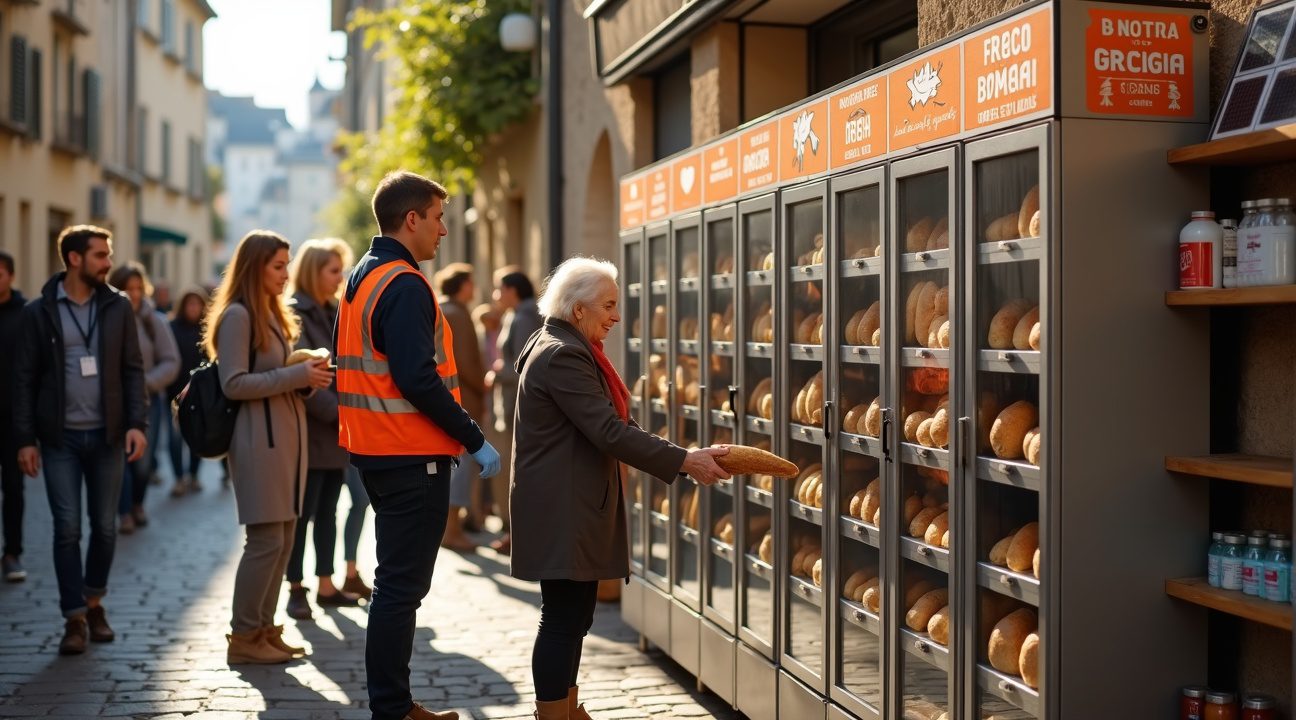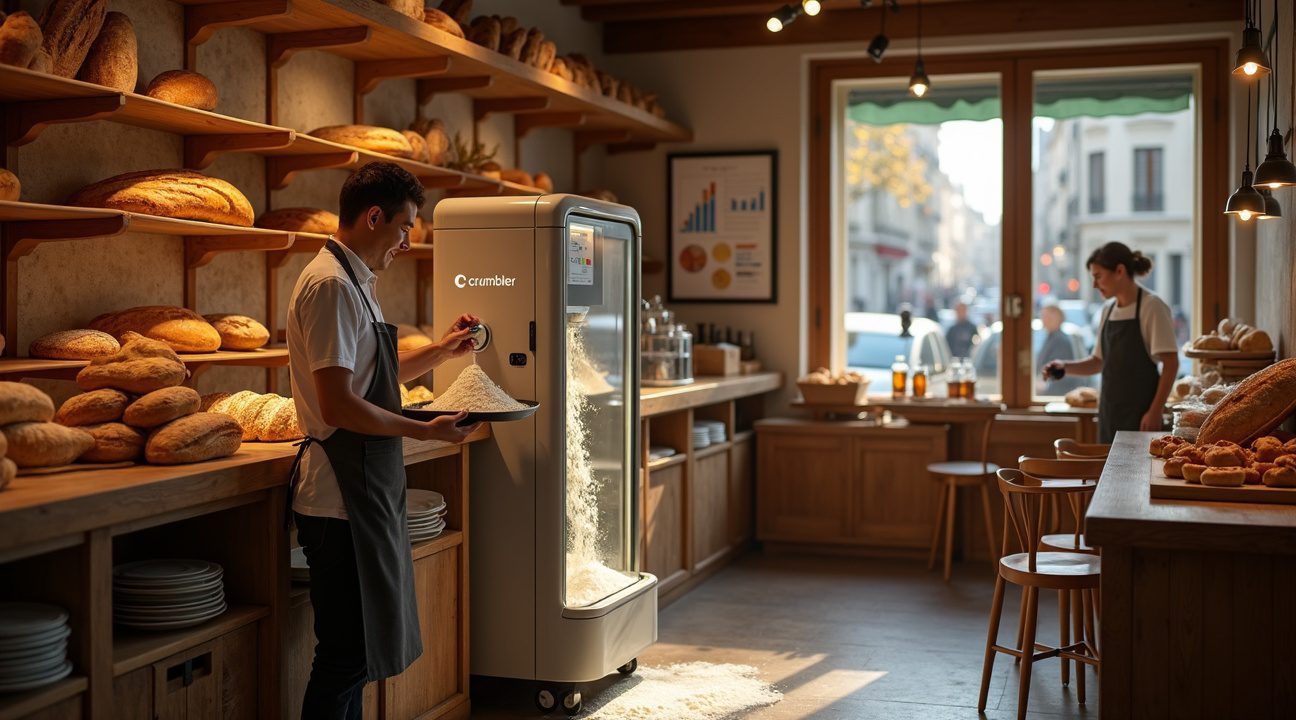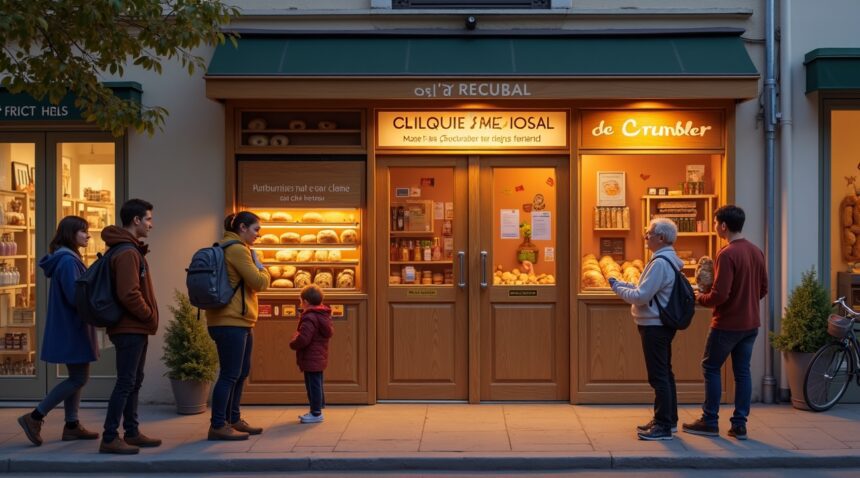French bakers have come up with a creative and compassionate response to fight food waste by introducing “box à pain”—refrigerated community lockers open 24/7 that provide unsold bread to anyone, completely free of charge.
Key Takeaways
- Community bread boxes function as chilled lockers where local bakeries deposit their leftover bread each day, making it accessible at all hours with no need for identification or payment.
- France produces around 150,000 metric tons of unsold bakery bread every year, with only 25% benefiting charitable causes and about 60% being discarded.
- Municipal workers and community volunteers uphold the cleanliness and safety of these bread boxes by conducting temperature monitoring, sanitation practices, and routine maintenance.
- The initiative has evolved to include additional items like spreads, water bottles, and other non-perishables, fostering broader community engagement and support.
- Bakeries are further reducing waste with Crumbler machines that transform stale bread into flour. This innovation, with 250 machines already in use, recycles an estimated 2-3 metric tons of bread per year per bakery.
Fighting Food Waste in a Meaningful Way
This project highlights a growing awareness of sustainability among French bakers. By adopting these innovative measures, such as the box à pain and Crumbler machines, communities are addressing systemic food waste while also supporting those in need. These small yet impactful efforts continue to inspire similar programs in other parts of the world.
Community Bread Vaults Transform Food Waste Into Community Support
How Box à Pain Systems Work
French bakers now place their unsold bread and baguettes into refrigerated community lockers at the end of each business day. These specialized containers, known as “box à pain” or bread lockers, operate as 24-hour food distribution points where anyone can retrieve fresh bread without cost or questions asked. The system creates a direct bridge between bakery surplus and community need.
Refrigeration technology keeps the bread fresh throughout the night and into the following day, maintaining quality standards that make the free bread genuinely useful for recipients. Many installations feature multiple compartments, allowing bakers to separate different types of bread and organize donations efficiently. The lockers typically hold between 20 to 50 loaves depending on their size and the bakery’s daily surplus.
Daily Maintenance and Community Involvement
Municipal workers or dedicated volunteers clean these bread vaults daily to ensure proper hygiene standards. This regular maintenance routine prevents contamination and keeps the lockers functioning as reliable food sources. Some municipalities have incorporated vault cleaning into existing sanitation schedules, while others rely on volunteer networks that have emerged around these installations.
The cleaning process involves several key steps that volunteers and workers follow consistently:
- Removing any remaining bread from the previous day
- Sanitizing all interior surfaces with approved cleaning solutions
- Checking refrigeration systems for proper temperature maintenance
- Restocking any auxiliary supplies like napkins or small utensils
- Documenting usage patterns to help optimize placement and capacity
Several bread box installations have expanded beyond their original scope by including shelves for donated spreads, jam, and water bottles. This evolution demonstrates how communities adapt the concept to address broader food security concerns. Local residents often contribute these additional items spontaneously, creating an informal network of mutual support around each vault.
Clear signage at each installation explains the system’s purpose and encourages community participation. These signs typically feature simple graphics showing how to access the bread and emphasize that the service is available to anyone without restrictions. Much like how Taylor Swift and Travis Kelce donated $100000 for community causes, these local initiatives demonstrate how both small and large-scale giving can make meaningful impacts.
The bread vault concept represents a recent innovation that addresses two pressing issues simultaneously: food waste reduction and increased food security. Unlike traditional food banks that require registration and specific operating hours, these lockers provide immediate access to fresh bread whenever someone needs it. This accessibility removes barriers that might prevent people from seeking help through conventional channels.
Installation locations are carefully selected to maximize both convenience for bakers and accessibility for community members. Many vaults sit directly adjacent to participating bakeries, making it simple for staff to transfer unsold inventory at closing time. Others are positioned in central locations that serve multiple bakeries within a neighborhood.
The success of these installations has sparked interest from municipalities across France, with many cities now exploring pilot programs or expanding existing networks. Some regions have developed standardized vault designs that can be manufactured and installed more efficiently, reducing costs for communities interested in starting their own programs.
Data collection at various installations shows consistent usage patterns, with peak access times typically occurring early morning and late afternoon. This information helps communities optimize their maintenance schedules and identify opportunities for program improvements. Some installations now include simple counting mechanisms that help track usage without compromising user privacy.
The concept continues evolving as communities discover new applications and improvements. Recent innovations include solar-powered refrigeration systems for areas with limited electrical infrastructure and modified designs that accommodate different types of baked goods beyond traditional bread loaves.

Why France Desperately Needs Bread Redistribution Solutions
I find it striking that bread ranks as the third most wasted food product in France, trailing only behind fruits and vegetables. This statistic reveals a significant gap between the country’s cherished baking traditions and its current food waste challenges. Each French person discards approximately nine baguettes worth of bread annually, amounting to 2.25 kilograms of stale bread and leftovers per individual.
The Scale of Bakery Waste
Artisanal bakeries across France generate an estimated 150,000 metric tons of unsold bread each year. I observe that this massive volume breaks down into concerning patterns:
- 60% of this bread ends up in dumpsters
- 25% reaches charitable organizations
- 15% gets converted into animal feed
These numbers highlight the urgent need for improved distribution systems. Despite France’s cultural reverence for fresh bread, the daily production cycle creates inevitable surpluses that current infrastructure can’t effectively manage. The gap between production and consumption demands innovative solutions that can bridge this disconnect.
Current Rescue Efforts and Their Limitations
Large supermarkets demonstrate what’s possible through mandated donation programs, rescuing 46,000 tons of food annually with bread comprising a substantial portion. However, I recognize that these efforts, while commendable, represent only a fraction of the total waste generated across France’s extensive network of independent bakeries.
The persistence of high bread wastage levels, even after implementing various rescue initiatives, underscores the complexity of this challenge. Traditional donation channels often can’t accommodate the daily rhythm of bakery operations or the short shelf life of fresh bread products. Many small bakeries lack the infrastructure or partnerships needed to efficiently redirect their unsold inventory.
Community box initiatives emerge as a practical response to these limitations. I see these simple redistribution systems as particularly valuable because they operate independently of complex logistics chains and can function at the neighborhood level. Unlike centralized donation programs that require coordination between multiple parties, community boxes allow bakeries to directly serve their local communities while reducing waste.
The success of such programs depends on community engagement and strategic placement. When bakeries consistently stock these boxes with quality unsold items, local residents develop trust in the system. This creates a sustainable cycle where community generosity helps address both food waste and food access challenges simultaneously.
France’s bread waste crisis requires multi-faceted solutions that complement existing rescue efforts. Community redistribution boxes represent one promising approach that can operate alongside larger-scale initiatives to maximize the recovery of this essential food staple.

How French Law Forces Supermarkets to Donate Food But Leaves Bakeries Behind
France revolutionized food waste prevention in 2016 with groundbreaking legislation that transformed how large grocery stores handle unsold products. The law prohibits major retailers from throwing away edible food that could benefit those in need, requiring partnerships with charitable organizations instead. Supermarkets now face penalties of approximately $4,000 for each violation, though enforcement remains inconsistent across different regions.
The Legal Framework Targets Big Business
The legislation specifically addresses large-scale food retailers, creating mandatory donation programs that redirect surplus inventory to food banks and charitable organizations. Since implementation, the French Federation of Food Banks reports donation increases exceeding 20%, demonstrating the law’s effectiveness in reducing commercial food waste. However, this regulatory approach focuses exclusively on supermarket chains and doesn’t extend its reach to smaller businesses like neighborhood bakeries.
The Bakery Gap Creates Community Solutions
Independent bakeries operate outside this legal framework, leaving them free to handle unsold bread through alternative methods. Many boulangeries have embraced community-driven solutions, placing surplus loaves in accessible boxes for public collection. This grassroots approach reflects French culture’s emphasis on reducing waste while supporting community bonds, even without legal mandates requiring such actions.
The absence of regulatory oversight for bakeries has actually fostered more creative and personal approaches to food redistribution. Unlike the structured partnerships mandated for supermarkets, bakery owners can respond directly to their neighborhood’s needs. Some establish informal relationships with local families, while others participate in community sharing initiatives that extend beyond simple charitable donations.
This legislative gap highlights how different business models require distinct approaches to waste reduction. Supermarkets operate with predictable inventory cycles and corporate structures that accommodate formalized charity partnerships. Bakeries, conversely, deal with daily production cycles and perishable goods that demand immediate solutions. The community box system emerges as a practical response that serves both businesses and residents without bureaucratic complexity.
Food waste reduction in France demonstrates how comprehensive change requires both top-down regulation and grassroots innovation. While supermarket laws create measurable improvements in donation volumes, bakery initiatives foster community engagement and immediate local impact. The combination of legal requirements for large retailers and voluntary community programs for smaller businesses creates a multi-layered approach that addresses food waste across different scales and contexts. This dual system proves that effective social change can emerge from both regulatory pressure and community initiative, with each approach serving its appropriate sector while contributing to the broader goal of reducing food waste.

How the Daily Bread Box System Actually Works
French bakers establish a simple yet effective routine by depositing their unsold loaves into designated community boxes each evening after closing their shops. I’ve observed this practice across numerous French communities where local bakeries contribute their excess bread rather than discarding it as waste.
Daily Operations and Maintenance
The bread boxes operate through a straightforward deposit system that requires no paperwork or verification process. Bakers simply place their leftover baguettes, croissants, and other baked goods into clean, weatherproof containers located in accessible public areas. Anyone can access these boxes at any time of day, creating a 24-hour food sharing resource for the community.
Municipalities and dedicated volunteers take responsibility for maintaining these bread boxes, ensuring they remain sanitary and organized. This oversight includes regular cleaning schedules, basic repairs, and monitoring to prevent misuse. Local authorities understand that proper maintenance directly impacts food safety and community participation rates.
Expanding Beyond Basic Bread
Many community boxes have evolved beyond simple bread distribution to include additional food items and beverages. I’ve noticed that some locations feature:
- Fresh produce from local markets
- Packaged goods approaching expiration dates
- Canned items and non-perishable foods
- Bottled water and beverages
- Prepared meals from restaurants
This expansion reflects a growing community sharing culture where neighbors contribute various food items spontaneously. The boxes become informal food banks that operate without the bureaucratic structure of traditional assistance programs.
The entire system functions on community trust, eliminating barriers that typically prevent people from accessing food assistance. No registration forms, income verification, or proof of need documentation exists. French communities have embraced this honor-based approach, recognizing that hunger affects people from all economic backgrounds.
Local regulations typically focus on basic hygiene standards rather than restrictive access controls. Municipal oversight ensures the boxes remain clean and functional while preserving the open-access philosophy that makes the system effective. This balance between safety and accessibility has allowed the bread box initiative to spread throughout French towns and cities.
The success of these community boxes demonstrates how simple solutions can address food waste and food insecurity simultaneously. Similar to how charitable initiatives gain momentum, the French bread box system has grown organically through community participation rather than top-down mandates.
French bakeries report high participation rates among their peers, with many establishments viewing the bread box contribution as a natural extension of their community role. This cultural integration ensures consistent daily deposits and maintains the reliability that community members depend on for accessing fresh bread.

French Bakeries Are Turning Stale Bread into Flour with High-Tech Machines
I’ve witnessed a remarkable transformation in French bakeries as innovative technology tackles food waste head-on. The Crumbler machine, developed by Bordeaux-based start-up Expliceat, represents a game-changing approach that converts unsold bread into usable flour and breadcrumbs right within the bakery premises.
The Crumbler Revolution
Expliceat has already sold 250 Crumbler machines across France, with each participating bakery typically recycling 2–3 metric tons of bread annually. These compact machines grind day-old or unsold loaves into fine flour that bakers can incorporate into new products, creating a circular economy within their operations.
The financial benefits prove compelling for bakery owners. A single Parisian bakery invested €2,500 in a Crumbler unit and reduced waste almost entirely while recovering their initial investment in under a year. This rapid return on investment demonstrates how sustainable practices can align perfectly with business profitability, much like how successful companies adapt to market demands.
Beyond Flour: Creative Upcycling Applications
French entrepreneurs aren’t stopping at flour production. Bread-based products have evolved to include innovative applications such as:
- Beer brewed from leftover bread, which has gained significant traction among environmentally conscious consumers
- Bread-based snacks and cereals that make use of finely milled crumbs
- Animal feed supplements utilizing stale but safe bread material
These recycled ingredients maintain quality while reducing environmental impact.
The technology complements traditional redistribution efforts effectively. Organizations like Linkee continue their important work, collecting and distributing approximately 8 metric tons of bread annually from Paris bakeries alone. However, the Crumbler machines address products that might be too old for human consumption but still valuable as ingredients.
Bakeries can now transform their waste stream into revenue while maintaining their commitment to quality. The recycled bread flour performs comparably to traditional flour in many applications, allowing bakers to reduce ingredient costs while appealing to sustainability-focused customers. This approach creates value from what was previously considered waste, turning a cost center into a profit opportunity.
The success of these machines reflects broader French attitudes about food waste reduction. Rather than simply accepting losses, innovative bakeries embrace technology that preserves the nutritional value of bread in alternative forms. This mindset shift has positioned France at the forefront of food waste innovation, inspiring similar initiatives across Europe.

These Community Initiatives Are Building Food Solidarity Beyond Just Reducing Waste
Community bread vaults operate as powerful symbols of social cohesion, transforming what could be wasteful disposal into acts of collective care. These simple wooden boxes, often handcrafted by local volunteers and positioned strategically throughout neighborhoods, create opportunities for neighbors to connect while addressing food insecurity. Unlike traditional food assistance programs that require documentation or means testing, anyone can access fresh bread without questions or judgment.
French cities like Roubaix have embraced zero-waste initiatives that combine municipal support with grassroots activism to create meaningful change. Local government partnerships with bakeries and community organizations demonstrate how policy can amplify citizen-led efforts. These programs don’t just divert bread from landfills—they establish networks of mutual aid that strengthen community bonds and create lasting social infrastructure.
Expanding Access Through Innovative Distribution Models
Community bread boxes fill critical gaps that traditional charity models often miss. While food banks and soup kitchens provide essential services, they typically operate during limited hours and may require travel to centralized locations. Bread boxes remain accessible 24/7 in residential areas where people actually live and work. This approach removes barriers that prevent many individuals and families from accessing help, particularly those with irregular schedules or transportation challenges.
The stigma-free design of these initiatives attracts users who might never visit formal assistance programs. Parents can stop by after school pickup, elderly residents can walk to nearby locations, and working families can access fresh bread without taking time off. This accessibility creates a more inclusive system that serves diverse community members while maintaining dignity for everyone involved.
Food solidarity extends beyond individual transactions to encompass broader social transformation. Regular users often become contributors, checking boxes during daily routines and refilling them when possible. Some volunteers report that donation patterns mirror community rhythms, with morning deliveries from early-rising bakers and afternoon redistributions from families with surplus groceries.
Community bread initiatives complement existing food recovery systems while addressing their limitations. Professional redistribution networks efficiently handle large volumes but struggle with last-mile delivery to individuals. Bread boxes bridge this gap by creating hyperlocal distribution points that operate through volunteer networks rather than formal logistics chains. This decentralized approach proves particularly effective in rural areas and urban neighborhoods where traditional services face operational challenges.
These grassroots programs demonstrate how environmental goals and social justice objectives can align through practical action. Every rescued loaf represents both waste diverted from disposal systems and nutrition provided to community members. This dual impact creates compelling narratives that attract diverse supporters, from environmental activists to social workers, building broad coalitions around shared values.
Sources:
Expliceat – “French Bakeries Are Turning Stale Bread into Flour with High-Tech Machines”
Linkee – “French Bakeries Are Turning Stale Bread into Flour with High-Tech Machines”
French Federation of Food Banks – “How French Law Forces Supermarkets to Donate Food But Leaves Bakeries Behind”
Roubaix (municipal program) – “These Community Initiatives Are Building Food Solidarity Beyond Just Reducing Waste”


